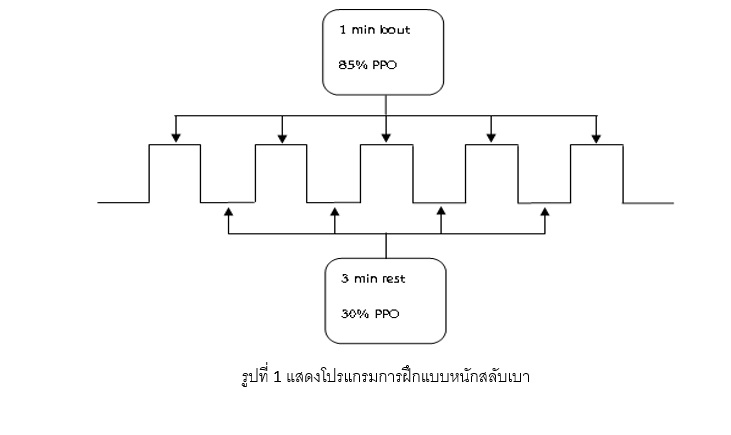EFFECTS OF HIGH-INTENSITY INTERVAL TRAINING ON BODY COMPOSITION, PULMONARY FUNCTION AND RESPIRATORY MUSCLES STRENGTH IN SEDENTARY ADULTS WITHOBESITY
Main Article Content
Abstract
Purpose
The purpose of this study was to investigate the effects of high-intensity interval training (HIIT) on body composition, pulmonary function, and respiratory muscles strength in sedentary adults with obesity.
Methods
Thirty-one physically inactive adults with obesity (male and female), aged between 18-45 years, were recruited from Chulalongkorn University and were randomized into 2 groups: high-intensity interval training group (n=15) and control group (n=16). The experimental group performed a high-intensity interval training (HIIT), 3 days a week for a period of 12-weeks, while the control group remained their normal activities of daily living. Physical characteristics, body compositions, pulmonary functions, and respiratory muscle strength were measured before and after 12 weeks of training. Data were analyzed using paired t-test and independent ttest with a level of statistical significant at p<.05.
Results
Following a 12-week training, the HIIT group displayed significant improvements in body weight, body mass index, resting heart rate, systolic and diastolic pressures, %body fat, lean body mass, maximum oxygen uptake (VO2max), forced vital capacity (FVC), forced expiratory volume in 1 sec (FEV1), peak expiratory flow rate (PEF), maximum voluntary ventilation (MVV), maximal inspiratory pressure (MIP), and maximal expiratory pressure (MEP) compared to prior training (all p<.05). In addition, the HIIT showed better improvements in body weight, resting heart rate, % body fat, VO2max, PEF, MIP, and MEP compared to the control (all p<.05).
Conclusion
A 12-week of HIIT is effective in improving in body composition, pulmonary function, and respiratory muscles strength in sedentary adults with obesity.
Article Details

This work is licensed under a Creative Commons Attribution-NonCommercial-NoDerivatives 4.0 International License.
References
Amira P. T., Pandiaman P., Erna M., Andika P., Ella R., Efriyandi E. (2018). Impact of Lower-Limb Endurance Training on Dyspnea and Lung Functions in Patients with COPD. Open Access Maced Journal of Medical Science, 6(12): 2354-2358.
Azad A., Gharakhanlou R., Niknam A. and Ghanbari A. (2011). Effects of aerobic exercise on lung function in overweight and obese students. Tanaffos, 10(3): 24-31.
Enright S. J., Unnithan V. B., Heward C., Withnall L., Davies D. H. (2006). Effect of high intensity inspiratory muscle training on lung volumes, diaphragm thickness, and exercise capacity in subjects who are healthy. Physical Therapy, 86(3): 345-354.
Chlif M., Keochkerian D., Choquet D., Vaidie A., and Ahmaidi S. (2009). Effects of obesity on breathing pattern, ventilatory neural drive and mechanics. Respiratory Physiology and Neurobiology, 168: 198-202.
Christopher Z., Helen L., Ian M. and Himender M. (2010). Obesity and respiratory diseases. International Journal of General Medicine, 2010; 3: 335-343.
Chuensiri N., Suksom D., and Tanaka H. (2018). Effects of high-intensity intermittent training on vascular function in obese preadolescent boys. Childhood Obesity, 14(1): 41-49.
Department of Health: Ministry of Public Health. (2561). Body mass index by self-evaluation [Online]. Available from: http://nutrition.anamai.moph.go.th/imagesfiles/HLworkingage.pdf [2018, April 24].
Dunham C. and Harms C. A. (2012). Effects of high-intensity interval training on pulmonary function. European Journal of Applied Physiology, 112(8): 3061-3068.
Len Kravitz. (2014). ACSM Information on High-Intensity Interval Training. [Online]. Available from: https://www.bgifitness.com/merchant/118/files/ACSM_HIIT.pdf [September 25, 2018].
Herbert P., Hayes L. D., Sculthorpe N. F. and Grace F. M. (2017). HIIT produces increases in muscle power and free testosterone in male masters athletes. Endocrine Connections 6(7): 430-436.
Littleton S. W. (2012). Impact of obesity on respiratory function. Respirology: official journal of the Asian Pacific Society of Respirology, 17(1):43-49.
Mäder U., Roth P., Furrer R., Brêchet J. P. and Boutellier U. (2001). Influence of continuous and discontinuous training protocols on subcutaneous adipose tissue and plasma substrates. International Journal of Sports Medicine, 22: 344–349.
McConnell A. (2013). Inspiratory muscle training: history and putative mechanisms. Frontiers in Sport and Exercise Science and Medicine Seminar on inspiratory muscle training, Centre for Sports Medicine and Human Performance, Brunel University.
Peterson B. A., Hastings B., Gottschall. (2016). High Intensity Interval Cycling Improves Physical Fitness in Trained Adults. Journal of Fitness Research, 5(1).
Scichilone N., Morici G., Marchese R., Bonanno A., Profita M., Togias A., Bonsignore M. R. (2005.) Reduced airway responsiveness in non elite runners. Medicine and Science in Sports and Exercise, 37(12): 2019-2025.
Sijie T., Hainai Y., Fengying Y. and Jianxiong W. (2012). High intensity interval training exercise training in overweight young women. The Journal of sports medicine and physical fitness, 52(3): 255-262.
Trapp E. G., Chisholm D. J., Freund J. And Boutcher S. H. (2008). The effects of high-intensity intermittent exercise training on fat loss and fasting insulin levels of young women. International Journal of Obesity, 32: 684-691.
World Health Organization (2018). Obesity and Overweight (Online). Retrieved April 24, 2018, from WHO Website: http://www.who.int/news-room/factsheets/detail/obesity-and-overweight


